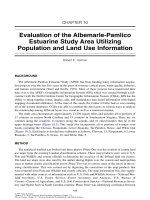Strategic management chapter 10 corporate governance
Bạn đang xem bản rút gọn của tài liệu. Xem và tải ngay bản đầy đủ của tài liệu tại đây (360.68 KB, 29 trang )
Corporate Governance
•
Corporate governance is:
–
The set of mechanisms used to manage relationships among stakeholders and to determine
and control the strategic direction and performance of organizations..
–
Concerned with identifying ways to ensure that strategic decisions are made more effectively.
–
Used in corporations to establish harmony between the firm’s owners and its top-level
managers whose interests may be in conflict.
© 2015 Cengage Learning. All rights reserved. May not be copied, scanned, or duplicated, in whole or in part, except for use as permitted in a license distributed with a certain product or service or otherwise on a password-protected
website for classroom use.
10–1
Separation of Ownership
and Managerial Control
•
Ownership Concentration
–
•
Relative amounts of stock owned by individual shareholders and institutional investors
Board of Directors
–
Individuals responsible
for representing the firm’s
owners by monitoring
top-level managers’
strategic decisions
© 2015 Cengage Learning. All rights reserved. May not be copied, scanned, or duplicated, in whole or in part, except for use as permitted in a license distributed with a certain product or service or otherwise on a password-protected
website for classroom use.
10–2
Separation of Ownership
and Managerial Control (cont’d)
•
Executive Compensation
–
The use of salary, bonuses, and long-term incentives to align
managers’ interests with shareholders’ interests.
•
Market for Corporate Control
–
The purchase of a firm that is underperforming relative to
industry rivals in order to improve its strategic
competitiveness.
© 2015 Cengage Learning. All rights reserved. May not be copied, scanned, or duplicated, in whole or in part, except for use as permitted in a license distributed with a certain product or service or otherwise on a password-protected
website for classroom use.
10–3
Figure 10.1
An Agency Relationship
© 2015 Cengage Learning. All rights reserved. May not be copied, scanned, or duplicated, in whole or in part, except for use as permitted in a license distributed with a certain product or service or otherwise on a password-protected
website for classroom use.
10–4
Agency Relationship Problems
•
Principal and agent have divergent interests and goals.
•
Shareholders lack direct control of large, publicly traded corporations.
•
Agent makes decisions that result in the pursuit of goals that conflict with those of the principal.
•
It is difficult or expensive for the principal to verify that the agent has behaved appropriately.
•
Agent falls prey to managerial opportunism.
© 2015 Cengage Learning. All rights reserved. May not be copied, scanned, or duplicated, in whole or in part, except for use as permitted in a license distributed with a certain product or service or otherwise on a password-protected
website for classroom use.
10–5
Agency Costs and Governance Mechanisms
•
Agency Costs
–
The sum of incentive costs, monitoring costs, enforcement costs, and individual financial
losses incurred by principals, because governance mechanisms cannot guarantee total
compliance by the agent.
•
Principals may engage in monitoring behavior to assess the activities and decisions
of managers.
–
However, dispersed shareholding makes it difficult and inefficient to monitor management’s
behavior.
© 2015 Cengage Learning. All rights reserved. May not be copied, scanned, or duplicated, in whole or in part, except for use as permitted in a license distributed with a certain product or service or otherwise on a password-protected
website for classroom use.
10–6
Agency Costs and Governance Mechanisms (cont’d)
•
Boards of directors have a fiduciary duty to shareholders to monitor management.
–
However, boards of directors are often accused of being lax in performing this function.
© 2015 Cengage Learning. All rights reserved. May not be copied, scanned, or duplicated, in whole or in part, except for use as permitted in a license distributed with a certain product or service or otherwise on a password-protected
website for classroom use.
10–7
Ownership Concentration
•
Ownership
Concentration (a)
•
Large block shareholders have
a strong incentive to monitor management closely:
–
Their large stakes make it worth their while to spend time,
effort and expense to monitor closely.
–
They may also obtain board seats which enhances their ability
to monitor effectively.
Financial institutions are legally forbidden from directly
holding board seats.
© 2015 Cengage Learning. All rights reserved. May not be copied, scanned, or duplicated, in whole or in part, except for use as permitted in a license distributed with a certain product or service or otherwise on a password-protected
website for classroom use.
10–8
Ownership Concentration (cont’d)
Ownership
Concentration (b)
•
The increasing influence of institutional owners (stock
mutual funds and pension funds)
–
Have the size (proxy voting power) and incentive (demand for
returns to funds) to discipline ineffective top-level managers.
–
Can affect the firm’s choice of strategies.
© 2015 Cengage Learning. All rights reserved. May not be copied, scanned, or duplicated, in whole or in part, except for use as permitted in a license distributed with a certain product or service or otherwise on a password-protected
website for classroom use.
10–9
Ownership Concentration (cont’d)
Ownership
Concentration (c)
•
Shareholder activism:
–
–
Shareholders can convene to discuss corporation’s direction.
If a consensus exists, shareholders can vote as a block to
elect their candidates to the board.
–
–
Proxy fights.
There are limits on shareholder activism available to
institutional owners in responding to activists’ tactics
© 2015 Cengage Learning. All rights reserved. May not be copied, scanned, or duplicated, in whole or in part, except for use as permitted in a license distributed with a certain product or service or otherwise on a password-protected
website for classroom use.
10–10
Ownership Concentration (cont’d)
Ownership
•
Board of directors
–
Concentration
Group of elected individuals that acts in the owners’ interests
to formally monitor and control the firm’s top-level executives
Board of Directors
(a)
•
Board has the power to:
–
Direct the affairs of the organization
–
Punish and reward managers
–
Protect owners from managerial opportunism
© 2015 Cengage Learning. All rights reserved. May not be copied, scanned, or duplicated, in whole or in part, except for use as permitted in a license distributed with a certain product or service or otherwise on a password-protected
website for classroom use.
10–11
Ownership Concentration (cont’d)
Ownership
Concentration
•
Composition of Boards:
–
–
Related Outsiders: individuals uninvolved with day-to-day
operations, but who have a relationship with the firm
Board of Directors
(b)
Insiders: the firm’s CEO and other top-level managers
–
Outsiders: individuals who are independent of the firm’s dayto-day operations and other relationships
© 2015 Cengage Learning. All rights reserved. May not be copied, scanned, or duplicated, in whole or in part, except for use as permitted in a license distributed with a certain product or service or otherwise on a password-protected
website for classroom use.
10–12
Table 10.1
Classification of Board of Directors’ Members
Group
Membership
Insiders
The firm’s CEO and other top-level managers
Related outsiders
Individuals not involved with the firm’s day-to-day operations, but who have a relationship with the
company
Outsiders
Individuals who are independent of the firm in terms of day-to-day operations and other relationships
© 2015 Cengage Learning. All rights reserved. May not be copied, scanned, or duplicated, in whole or in part, except for use as permitted in a license distributed with a certain product or service or otherwise on a password-protected
website for classroom use.
10–13
Ownership Concentration (cont’d)
Ownership
Concentration
•
Criticisms of Boards of Directors include:
–
Too readily approve managers’
self-serving initiatives
Board of Directors
–
Are exploited by managers with personal ties to board
members
(c)
–
–
Are not vigilant enough in hiring and monitoring CEO behavior
Lack of agreement about the number of and most appropriate
role of outside directors.
© 2015 Cengage Learning. All rights reserved. May not be copied, scanned, or duplicated, in whole or in part, except for use as permitted in a license distributed with a certain product or service or otherwise on a password-protected
website for classroom use.
10–14
Ownership Concentration (cont’d)
Ownership
Concentration
Board of Directors
•
Enhancing the effectiveness
of boards and directors:
–
–
(d)
More diversity in the backgrounds of board members
Stronger internal management and accounting control
systems
–
–
–
More formal processes to evaluate the board’s performance
Adopting a “lead director” role.
Changes in compensation of directors.
© 2015 Cengage Learning. All rights reserved. May not be copied, scanned, or duplicated, in whole or in part, except for use as permitted in a license distributed with a certain product or service or otherwise on a password-protected
website for classroom use.
10–15
Ownership Concentration (cont’d)
Ownership
•
Concentration
•
Board of
Directors
Forms of compensation:
–
Salaries, bonuses, long-term performance incentives, stock
awards, stock options
Factors complicating executive compensation:
–
Strategic decisions by top-level managers are complex, nonroutine and affect the firm over an extended period.
–
Other variables affecting the firm’s performance over time.
Executive
Compensation (a)
© 2015 Cengage Learning. All rights reserved. May not be copied, scanned, or duplicated, in whole or in part, except for use as permitted in a license distributed with a certain product or service or otherwise on a password-protected
website for classroom use.
10–16
Ownership Concentration (cont’d)
Ownership
Concentration
Board of
Directors
•
Limits on the effectiveness of executive compensation:
–
–
–
–
Unintended consequences of stock options
Firm performance not as important than firm size
Balance sheet not showing executive wealth
Options not expensed at the time they are awarded
Executive
Compensation (b)
© 2015 Cengage Learning. All rights reserved. May not be copied, scanned, or duplicated, in whole or in part, except for use as permitted in a license distributed with a certain product or service or otherwise on a password-protected
website for classroom use.
10–17
Ownership Concentration (cont’d)
Ownership
Concentration
•
Board of
Individuals and firms buy or take over undervalued
firms.
Directors
–
Ineffective managers are usually replaced in such
takeovers.
Executive
Compensation
•
Threat of takeover may lead firm to operate more
efficiently.
Market for
Corporate Control (a)
•
Changes in regulations have made hostile takeovers
difficult.
© 2015 Cengage Learning. All rights reserved. May not be copied, scanned, or duplicated, in whole or in part, except for use as permitted in a license distributed with a certain product or service or otherwise on a password-protected
website for classroom use.
10–18
Ownership Concentration (cont’d)
Ownership
•
Concentration
mounting a takeover
•
Board of
Directors
Executive
Compensation
Managerial defense tactics increase the costs of
•
Defense tactics may require:
–
Asset restructuring
–
Changes in the financial structure of the firm
–
Shareholder approval
Market for corporate control lacks the precision of
internal governance mechanisms.
Market for
Corporate Control (b)
© 2015 Cengage Learning. All rights reserved. May not be copied, scanned, or duplicated, in whole or in part, except for use as permitted in a license distributed with a certain product or service or otherwise on a password-protected
website for classroom use.
10–19
International Governance
•
•
The following slides exhibits how organizations in Germany,
Japan, and China are governed.
The found these following four slides to be interesting:
© 2015 Cengage Learning. All rights reserved. May not be copied, scanned, or duplicated, in whole or in part, except for use as permitted in a license distributed with a certain product or service or otherwise on a password-protected
website for classroom use.
10–20
International Corporate Governance
•
Germany
–
Owner and manager are often the same in private firms.
–
Public firms often have a dominant shareholder, frequently a
bank.
–
Frequently there is less emphasis on shareholder value than in
U.S. firms, although this may be changing as German firms
are gravitating toward U.S. governance mechanisms.
© 2015 Cengage Learning. All rights reserved. May not be copied, scanned, or duplicated, in whole or in part, except for use as permitted in a license distributed with a certain product or service or otherwise on a password-protected
website for classroom use.
10–21
International Corporate Governance (cont’d)
Germany: Two-tiered Board
Vorstand
Responsible for the functions of direction and
management
Responsible for appointing members to the Vorstand
Aufsichtsrat
Union
members Shareholders
Responsible for appointing members to the
Aufsichtsrat
© 2015 Cengage Learning. All rights reserved. May not be copied, scanned, or duplicated, in whole or in part, except for use as permitted in a license distributed with a certain product or service or otherwise on a password-protected
website for classroom use.
10–22
International Corporate Governance (cont’d)
•
Japan
–
–
Important governance factors:
•
Obligation
•
“Family”
•
Consensus
Keiretsus: strongly interrelated groups of firms tied together by
cross-shareholdings.
–
Banks (especially “main bank”) are highly influential with firm’s
managers.
© 2015 Cengage Learning. All rights reserved. May not be copied, scanned, or duplicated, in whole or in part, except for use as permitted in a license distributed with a certain product or service or otherwise on a password-protected
website for classroom use.
10–23
International Corporate Governance (cont’d)
•
Japan (cont’d)
– Other governance characteristics:
•
•
•
•
Powerful government intervention
Close relationships between firms and government sectors
Passive and stable shareholders who exert little control
Virtual absence of external market for corporate control
© 2015 Cengage Learning. All rights reserved. May not be copied, scanned, or duplicated, in whole or in part, except for use as permitted in a license distributed with a certain product or service or otherwise on a password-protected
website for classroom use.
10–24
International Corporate Governance (cont’d)
•
China
–
Corporate governance practices
have been changing and evolving
with increasing privatization of businesses.
–
–
–
Development of internal equity markets has been hampered by insider trading.
Equity held in state-owned enterprises is decreasing.
The state relies on direct economic controls, indirect social goals influences, and limitations
on access to resources to influence the strategies firms use.
© 2015 Cengage Learning. All rights reserved. May not be copied, scanned, or duplicated, in whole or in part, except for use as permitted in a license distributed with a certain product or service or otherwise on a password-protected
website for classroom use.
10–25









